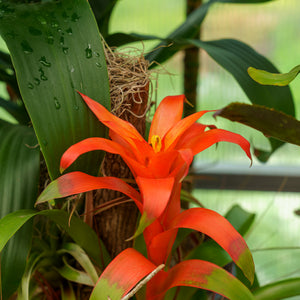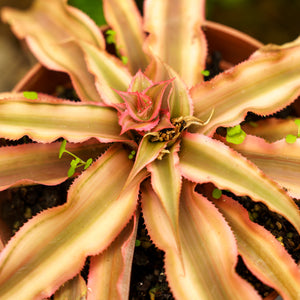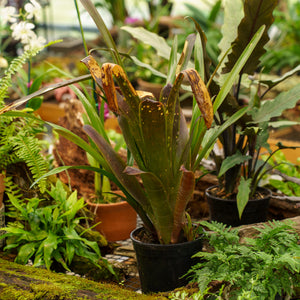The Bromeliad Guide
Bromeliads are exotic, easy-care plants prized for their striking foliage and long-lasting, vibrant blooms. Native to tropical and subtropical regions of the Americas, these adaptable plants thrive both indoors and outdoors, making them a favorite for houseplant enthusiasts and landscape designers alike. With unique watering needs and bold colors, bromeliads add a tropical touch to any space. Here’s everything you need to know about growing and caring for bromeliads.
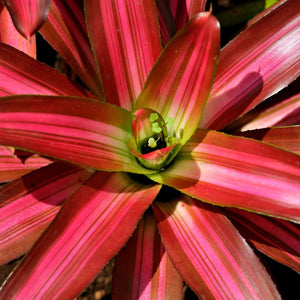
About
Bromeliads belong to the Bromeliaceae family, which includes over 3,000 species. They are epiphytic or terrestrial plants, meaning they can grow attached to trees, rocks, or in soil. Their rosettes of stiff, colorful leaves form a central cup, which collects water and nutrients in their native rainforest habitats.
Popular varieties include Neoregelia 'Wine & Gold', a colorful, compact variety perfect for indoor growing; Cryptanthus 'Red Star', known for its star-shaped rosette and deep red hues; and Tillandsia cyanea, an air plant that produces a showy pink bloom spike. Other notable selections include Billbergia 'Hallelujah', with cascading growth and vibrant flowers, and Neoregelia carcharodon 'Skotak's Tiger', which features bold striped foliage.
Bromeliads are admired for their ability to thrive with minimal care, requiring only occasional watering and bright, indirect light. They make excellent houseplants, thrive in greenhouses, and can even be grown outdoors in warm climates.
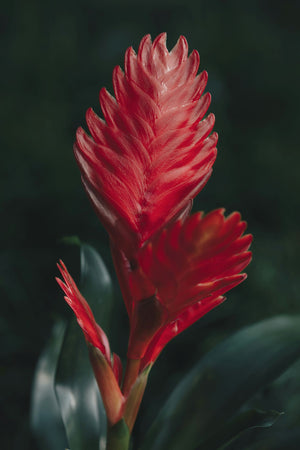
PLANTING
- USDA Hardiness Zones: Most bromeliads thrive in Zones 9-12, but they can be grown as houseplants in cooler regions.
- Soil: Prefers a fast-draining mix, such as orchid bark or a peat-based bromeliad blend. Epiphytic varieties can be mounted on wood or grown in hanging baskets.
- Sunlight: Prefers bright, indirect light. Some species tolerate more sun, while shade-loving types like Cryptanthus do best in lower light conditions.
- Watering: Fill the central cup with water and refresh it weekly. Avoid letting the cup become stagnant to prevent rot.
- Spacing: Space plants 12-24 inches apart for good airflow and healthy growth.
- Planting Time: Bromeliads can be planted or repotted at any time of the year, though they grow most actively in warm seasons.
To plant a bromeliad, use a well-draining potting mix, ensuring the plant is secure but not buried too deeply. For epiphytic bromeliads, attach them to a wooden mount with wire or natural twine.
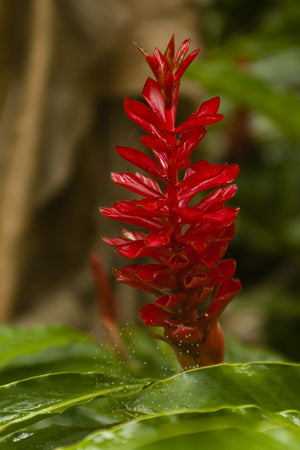
CARE
- Watering: Keep the central cup filled with clean, non-chlorinated water. Empty and refresh it weekly to prevent bacteria buildup. If grown in soil, water sparingly, allowing the top inch to dry between watering.
- Fertilizing: Use a diluted liquid fertilizer monthly during the growing season. Avoid heavy feeding, as bromeliads require minimal nutrients.
- Pruning: Remove spent flowers and dead leaves to maintain a tidy appearance.
- Pests & Diseases: Generally pest-free but may attract mealybugs or scale. Treat with insecticidal soap if needed.
- Repotting: Bromeliads rarely need repotting. After flowering, the mother plant will produce pups (offsets), which can be separated once they are about half the size of the parent plant.

HOW TO USE
Bromeliads’ striking foliage and unique growing habits make them a versatile choice for various settings:
- Houseplants: Thrives in containers with bright, indirect light.
- Terrariums & Vivariums: Small varieties like Cryptanthus are excellent for enclosed tropical environments.
- Epiphytic Displays: Mounted bromeliads, such as Tillandsia cyanea, add a unique, artistic touch to walls and hanging gardens.
- Tropical Landscapes: In warm climates, bromeliads make excellent ground cover or accent plants in shaded garden beds.
- Greenhouses & Sunrooms: Provides a lush, exotic display with minimal care.

COMMON QUESTIONS
- How to care for a Bromeliad plant? Provide bright, indirect light, keep the central cup filled with water, and avoid overwatering the soil.
- How to water a Bromeliad? Fill the plant’s central cup with water, refreshing it weekly. In dry environments, mist the leaves occasionally.
- Is Bromeliad toxic to cats? No, bromeliads are non-toxic to cats and safe for pet-friendly homes.
- Is Bromeliad toxic to dogs? No, bromeliads are safe for dogs and do not contain harmful toxins.
- How often to water Bromeliad? Refresh the water in the central cup weekly. If planted in soil, water lightly when the top inch becomes dry.
- Can you eat pineapple bromeliad? Yes, pineapples (Ananas comosus) are a type of bromeliad, and their fruit is edible.
- Does Bromeliad need sun? Bromeliads prefer bright, indirect light. Some varieties tolerate direct sun, while others thrive in shade.
- How to get a Bromeliad to bloom? Bromeliads bloom only once, but you can encourage blooming by placing the plant in a bag with a ripe apple for a few days. The ethylene gas from the apple stimulates flower production.
CONCLUSION
Bromeliads are exotic, low-maintenance plants that bring tropical beauty to any indoor or outdoor space. Whether displayed as houseplants, mounted epiphytes, or landscape accents, their striking foliage and unique growth habits make them an eye-catching addition. With varieties like Billbergia 'Hallelujah', Neoregelia ampullacea 'Black Tiger', and Cryptanthus 'Elaine', there is a bromeliad for every plant lover. Explore our collection and bring a touch of the tropics to your home or garden.
The Bromeliad Collection
Sold Out
Sold Out
Sold Out
Sold Out
Sold Out



